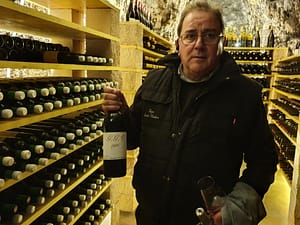The rain in Spain was falling on the plains that day. Castilla, otherwise known for its dry, almost prairie-like landscape, was even less inviting than usual. I met a man in a cowboy hat. His name was Goyo.
I will not embark on a wild west novel. I had indeed been invited to Gumiel del Mercado (province of Burgos) by Goyo García Viadero, one of the new guns of Ribera del Duero. Goyo makes expressive, lightly extracted, terroir-focused wines without additives and without oakiness, in a region rather famous for the opposite.
I had originally been aware of Goyo through his sister, who is winemaker at Bodegas Valduero in the same village. In fact Goyo gets his oak barrels from them. He explains:
-I don’t like oak, it’s not from the grape, not from the soil. So the barrels he uses are always at least 7-8 year old barrels, and from Valduero. He uses oak with ultrafine grain, -because I like a slow evolution.
He has a careful approach to winemaking. All grapes are destemmed by hand, pressed gently, and fermentations are slow in the cold, ancient cellar. For the wines that age in barrel, Goyo uses, as we have heard, more than 7-8 year old very finely grained barriques from Bordeaux. Sulfur and other additives are never used. The resulting wines have a striking sincerity and elegance that communicate a strong sense of place. All vineyards have 800 meters or more of altitude, quite impressive. The sun of the meseta and the high altitudes bring both phenolic concentration and bright acidity to the wines.
His bodega dates from the Roman times. Upon meeting there we tasted through a number of wines from tank and barrel, some of them from vineyards both here and in the Soria province. Among these was the white skin-contact García Georgieva Malvasía 2021 from tank, a wine with a lovely fresh acidity. The wine was pressed in an old basket press, fermented in steel with 14 days skin contact and malolactic fermentation. Bottled without fining, filtration or added SO2. Another was the Finca los Quemados Clarete 2021 from all tinto fino (or: tinto del país), a clone of tempranillo, with its splendid cherry fruit. It’s made with short maceration (5-6 days), according to the most common style of the region. The Los Quemados vineyard has almost 60 year old vines planted on red sands with pebbles 960 meters above sea level.
Here we also tasted one of my personal favourites, a house-wine so to speak. Joven de Viñas Viejas 2021, which means young/unoaked wine from old vines, gets a richness and concentration from the age of the vines and the low yield, and it does not need any oak. It’s from a dry-farmed vineyard planted entirely with tinto fino at 880 meters altitude. The grapes are hand-harvested, destemmed and fermented with wild yeasts in steel tank with 3 months of skin maceration, then raised in tank before being bottled without fining, filtration or any addition of SO2. Dark, lovely, concentrated fruit (blackberry, morello); juicy with fine tannins and and lovely acidity.
All the vineyards are old; the youngest 40 years, the oldest more than 100. Goyo never uses filtration, almost no additives (only sulphur and copper in the vineyards).
-Most important is the quantity of tartaric acid in the grape. It should be 7 or 8 grams tartaric acid per litre, says Goyo. All grapes are destemmed. The maceration lasts for 10-15 days at 6 degrees, and fermentation takes place at no more than 22 degrees. -We only play with temperature and batonnage, says Goyo about possible variables.
His adventure began in 2003 with three parcels of old vines, that he says the French public call “the three musketeers”, named Finca Valdeolmos in Villabuena de Gumiel (90% tinto fino, 10% of the white albillo), Finca el Peruco in Olmedillo de Roa (85% tinto fino, 15% albillo), and Finca Viñas de Arcilla in Anguix (100% tinto fino), that are still the basis of his portfolio. From these he produces his three single vineyard wines and his annual Reserva Especial, all made the same way, with two to three years in barrel. -All this is a nod to the area’s past, before it became too commercial, he says. Valdeolmos, nicknamed “the elegant” has limestone. Finca el Peruco, “the fine”, has white sand and is one of the highest in Ribera, with over 900 meters of elevation. While Finca Viña de Arcilla, “the serious”, has clay, as the name implies.
We tasted the 2017 of the three wines. Finco Valdeolmos 2017 has dark fruits (blackberry), touch of licorice; gentle tannins and some minerality. Finca el Peruco 2017 holds back, is even more mineral: evident tannins, salty (from the white sand). Finca Viña de Arcilla 2017 is more balsamic (pine, encina), evident tannin, but also more fruit. Reserva Especial is made from Goyo’s favourite each year. This wine first ages in the same fashion as the three. Then it’s blended and gets another one or two years before release. We tasted the 2015, a blend of the three. This showed a slight mousiness, so down in the storing cellar we felt like trying the 2016 also. This one was in good condition, in that vintage made only from Valdeolmos. Down in the storing cellar we also tasted the 2018 vintage of all the three muscateers.

Goyo also makes wine in Cantabria, the region where his mother comes from. He has 2 hectares of mencía and palomino grapes on slate in the mountainous Liébana Valley. Here he makes a red wine and skin-contact white wine. These are called Beâtum from the 2019 vintage on (formerly Cobero).
Beâtum Tinto is made from 80% mencía and the rest palomino fino. The latter is the same as the sherry grape. This vineyard blend is often found in the vineyards of northern Spain. The vines here are more than 80 years old and are planted on broken slate soils. The red and white grapes are co-fermented with indigenous yeasts, then raised one year in French oak barrels, without any sulfur additions. The red is typically made of 80% mencía and the rest palomino fino. The latter is the same as the sherry grape. We tasted the 2019: Very dark; super expressive, floral (violets), a touch licorice; lovely mouthfeel, luscious and [a bit spritzy]. Beâtum Blanco is made from bush vines of palomino grown on brown slate soils at 500-600 meters elevation around the town of Potes in the Valle de Liébana, Picos de Europa. It’s fermented on the skins in stainless steel tanks without added yeast, and bottled without sulfur additions. The 2020 smelled of mature apples and orange peel; it was quite full in the mouth, some tannin.
On the way out: One of the wines was Tempranillo a Mano 2019, where he takes the best grapes from every bunch, so it takes 3 parcels to fill a big barrel. The wine was big and bold, darke with some coffee. Finca de Quemado Clarete 2019, with one year in barrel, was lovely scented and perfumed. Graciano a Mano 2019 was dark and very fruity, light-bodied but long. Its origin is the Finca Guijarrales (formerly Finca Cascorrales), a vineyard planted entirely with graciano.
Leave a Comment



























































